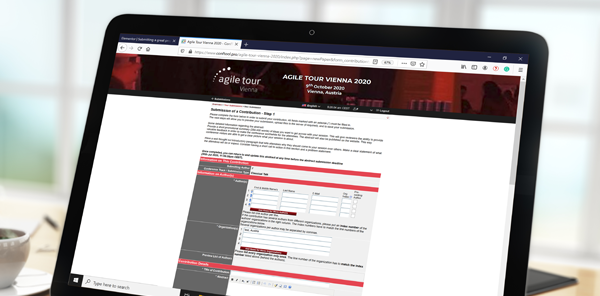Ralph Miarka, a seasoned committee member and reviewer, describes how to submit your talk. He points out what you should pay attention to, what you should highlight and where mistakes can quickly happen. This post is designed with our submission program ConfTool in mind, but can be applied for other conferences too.
You want to give a talk at a conference to present your experience, knowledge or interact with a group to discover new things? Great! Below you will find a short description of what to look out for when submitting a proposal. I write this as a regular reviewer on many conferences. I enjoy doing this for about ten years now and I read a fair share of proposals.
First, please keep in mind that reviewers are human beings. They invest their time (for free) to support the organisation of a conference. Motivation differs. Some want to ensure a great program they would attend themselves. Others like to learn new things early, and almost everyone wants to support you, the submitter, in their development. Whatever the reason, you write to them in the first place.
Imagine, there are hundreds of submissions and only a limited number of spots. Every entry should get at least three to four evaluations. Thus, each reviewer looks at approximately 50 proposals (or more) and has to make – sometimes disagreeable – decisions. Remember, they do it in their spare time. Would you agree that it might be helpful to make the job delightful when you want to get accepted? I hope you do!
Submission Period
At most conferences, there is a submission period. That means there is a deadline to keep. If you want to get comments and thus a chance to improve your proposal, I encourage you to hand it in early, before the reviewers assess it. Submit early too, if you wish to have less-stressed reviewers. Remember, their good mood is helpful for your chance to be accepted.
Please fill in all parts of the submission form. That is often the first impression we, the reviewers, get about your proposal. Better make it a good one! 🙂
The Title
Give the talk a catchy title so that we get curious and eager to read your work. “Improving Your Retrospective” is informative, though maybe not appealing enough. “Five Steps to Improve Your Retrospective” is often better. However, what does improve mean in this context? A lot has been written and said about retrospectives, so I prefer a bit more specific caption like: “Five New Activities I Learnt from Home-schooling to Engage My Team in Retrospectives.”
The Abstract
Please provide an abstract that will intrigue both potential audience and us as well. That is your most important advertisement. Give away a little from the content, yet not too much. Be clear what people can expect to get out of this session. In many cases, this box has a limited capacity – make the most of it.
Often you are asked for an “Extended Abstract”. Please don’t copy and paste the short abstract from above. Extended means that you expand all the points addressed before. Describe in detail the context of this approach, experience, or else. Tell us more about what you and others did and what you learned. Add specific methods you applied in your work, too. Imagine, this is a whole one-pager. When I read the same text twice in a submission, it often devalues the contribution for me.
I find it helpful when the abstract and the extended one relate to the conference theme as well as to the particular track. It shows me that you took the time to check out the event site and to think a bit about your audience. For instance, once I read the same submission three times. The author didn’t address any specifics of the respective conferences. It certainly cost him some review points from my side.
Learning Outcomes
Learning outcomes are statements that describe the knowledge or skills people can acquire from the session. Each sentence typically starts with “Participants will learn/see/experience …” followed by the outcome, for example, “… about three tools we developed to enhance our test automation”. What could they know afterwards they might not have known before? Only promise what you can provide. So “… will discover a way how to earn a Million Euros” is a promise you may not be able to keep. Better, in this case, might be “They will learn how I earned my first Million Euros by applying XYZ”.
Please note that the text you wrote so far is often visible for the public. When your session is accepted, these parts will be published on the website or in the event app.

"Reviewer's Eyes Only!"
The box “Session Outline” is the place to write everything for the reviewer’s eyes only. Tell them exactly how your session is going to unfold. What exercises do you plan to do? What questions will you ask the audience? What point will you make and when? Provide a structure of your talk or workshop – and include timings. Some submissions contain precise descriptions like: “3 Min – Speaking to the neighbour about their highlight of the day”, and so on. The more detail, the easier it is for the reviewer to pre-live your session. Frankly, many submissions get rejected when this box is empty, or the content is meaningless to the reader.
Most reviewers are experienced conference visitors and have seen a lot. Their job is to decide which sessions they prefer over another. In other words, they want to know what is new, what is supposedly desirable for the attendees, what surprises do you offer and whether this is suitable for this audience. Include technical or organisational needs, like flipcharts and pens you want, free wall space for group work, an old overhead projector, etc. Organisational needs could also mean that your session fits better in the morning as it supports the get-to-know each other or in the evening as it reflects on the day. Include a link to a presentation or a video, enriching the picture about you and your style. Early in the process, we have time to look at it. Later on, we might check this just when we are in doubt about the submission.
Please stay away from marketing messages about your fantastic company or your great product. That puts off a lot of reviewers – it certainly puts me off.
I recommend that you read through your proposal once more. I use Grammarly and Papyrus to improve spelling, grammar and style. Finally, let someone else check the submission before handing it in. Tell this person what to look out for and ask for constructive feedback to improve your piece further. Many reviewers that I know use the perfection game: “On a scale of 0-10, I give this an X. I find good about it … and to give it a 10, I wish for …”.
"It's a tough choice!"
You did everything that’s written here and elsewhere? Your proposal was great, yet it didn’t get accepted? How come? Often, we find ourselves in the situation that there are several excellent submissions with similar content. We check your session against the other proposals in the context of the conference theme, the track and yes, personal preferences. Some favor well-known speakers, others want to give first-timers a chance. Depending on the overall program, we make tough choices – please understand that.
I wish you much success and a portion of luck to get your session accepted for your preferred conference.
With that being said: Become a speaker at our conference!
References:
- Creating a Great Submission. Agile Alliance. Online: https://www.agilealliance.org/agile2020/submission-process/#great-submissions (last access April 11th, 2020)
- Mitch Lacey. Getting your Session Accepted to the Agile Alliance Agile Conference. Online: https://www.mitchlacey.com/blog/getting-your-session-accepted-to-the-agile-alliance-agile-conference.html (last access April 11th, 2020)
- Joanne Perold. How to get your conference submissions accepted. Agile 42. July 17th, 2017. Online: https://www.agile42.com/en/blog/2017/07/17/how-to-get-your-conference-submissions-accepted/ (last access April 11th, 2020)
- Ralph E. Johnson et. al. How to Get a Paper Accepted at OOPSLA. PANEL at OOPSLA’93. Online: http://classic.sigplan.org/oopsla/oopsla96/how93.html (last access April 11th, 2020)
- Grammarly – https://app.grammarly.com
- Papyrus Author (EN) – https://www.papyrusauthor.com/
- Papyrus Autor (DE) – https://www.papyrus.de/
- Jim and Michele McCarthy. Perfection Game. Live In Greatness, 2010. Online: https://liveingreatness.com/core-protocols/perfection-game/ (last access April 11th, 2020)






